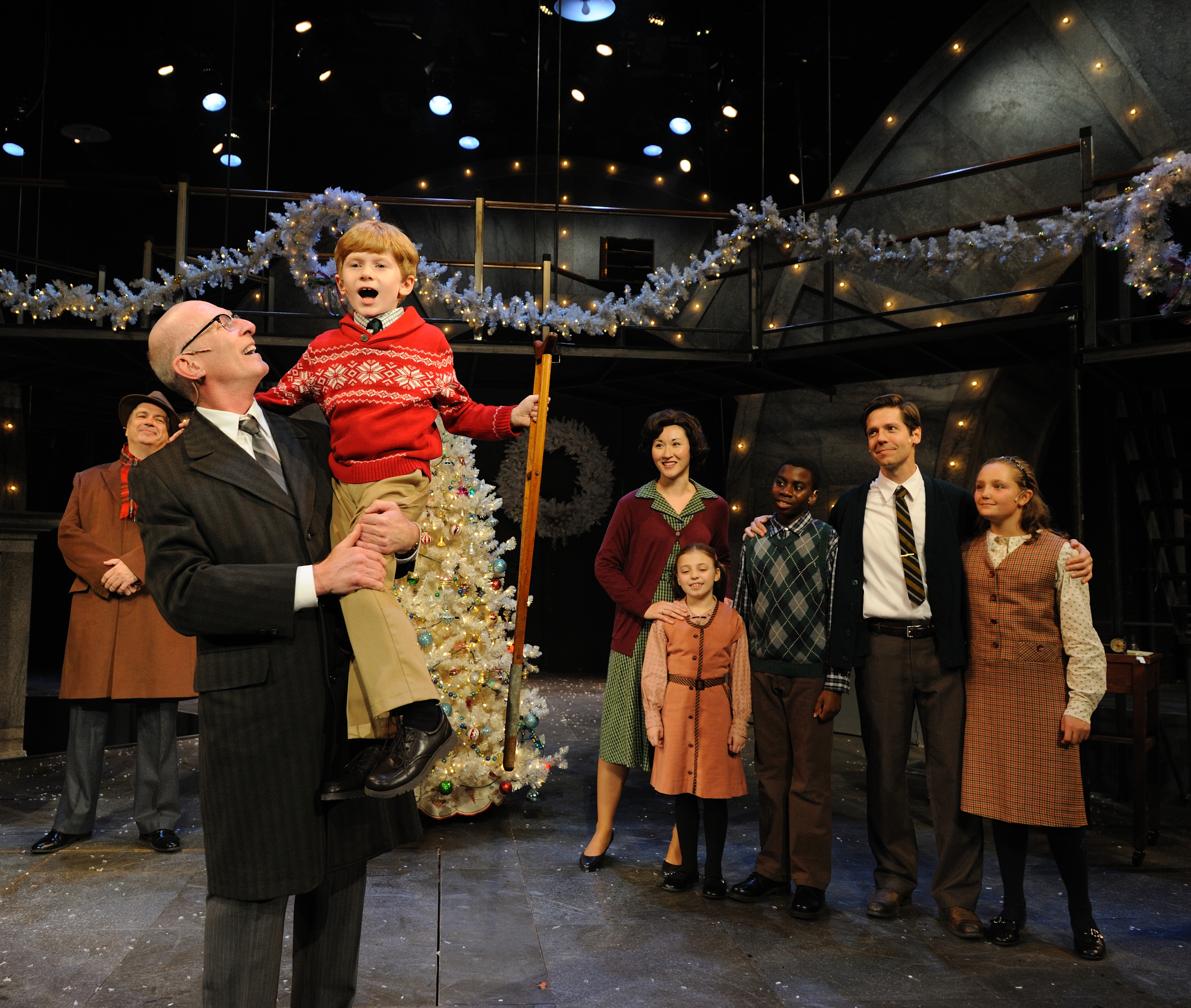
Brian McEleney as Ebenezer Scrooge and the cast of the 35th annual production of Dickens' A Christmas Carol, adapted by Adrian Hall and Richard Cumming, directed by Christopher Windom, presented by Cardi’s Furniture with supporting sponsor Amica Insurance. Performances will be November 18 - December 30 in the Chace Theater. Set design: Michael McGarty; Costume Design: William Lane; Lighting Design: John Eckert. Photo by: Mark Turek.
A Christmas Carol, adapted from Charles Dickens’ novel by Adrian Hall and Richard Cumming, original music by Richard Cumming, Trinity Repertory Company, 11/18/11-12/30/11, http://www.trinityrep.com/on_stage/current_season/ACC.php.
Reviewed by Craig Idlebrook
(Providence, RI) At first glance, it seems easy to perform A Christmas Carol; just round up the usual characters from last year and dust off the crutch. But staging a play that everyone knows can present a challenge because of audience dogma; everyone has an idea of the way the play should go. A director can be ridden out on a rail if s(he) strays too far from the collective idea of the play.
Confronted with such a double-edged sword, directors have two options. They may either decide to stage the play faithfully, trying to bring out bits of nuance to keep theater-goers and actors from falling asleep, or stage the play in a new way that helps the audience examine why it has become such a cultural icon.
Unfortunately, the Trinity Repertory Theater’s staging of A Christmas Carol seems to muddle the two options, and it succeeds only because it leans on the holiday goodwill of the audience and the brilliant timing of Stephen Thorne, the production’s Bob Cratchit. The play misses the sweetest moments of Dickens’ text and replaces them with jarring ones.
Though set in 1959, the script mainly uses dialogue straight from Dickens.
This juxtaposition would work if a vision of 1959 were fully fleshed out in the set design. But most of the set consists of what appear to be two drab heating ducts and some walkways, seemingly to reflect Scrooge’s sterile world.
The problem is it never becomes anything more. The magic of the original story is to show the drab streets of the Industrial Revolution transforming with the Christmas spirit in all but Scrooge’s corner; finally, Christmas color bursts through even there.
Christmas decorations come and go through the play, but they are too small to overtake the gloom and end up looking more like leftover party decorations found in February. The stage’s lack of definition also creates a missed opportunity to connect the sooty excesses of Dickens’ Industrial Revolution with the prefab excess of postwar America.
There are curious additions to the original plot-line, all which weaken the play. The worst offender is a ghoulish song in the opening minutes, with Scrooge (Brian McEleney) ignoring Marley (Richard Donelly) as his only friend gasps his last breath him. And young Scrooge’s fiancée (Lauren Lubow) reveals he drove his beloved boss out of business. Both of these embellishments make it hard to root for Scrooge’s redemption. Even a villain needs to have some heart, and Scrooge has enough baggage for us to lift.
The flawed script isn’t helped by the direction. The actors seem to have been told to deliver their lines as if they had planes to catch after the show. And there is a tendency of volume over substance in many of the key scenes.
What’s frustrating is these shortcuts nearly obscure some wonderful moments in the play. Thorne effortlessly captures the sweetness and naiveté of the season in his portrayal of Scrooge’s beleaguered clerk. His comic timing may be a bit too Will and Grace for the fifties, but that’s okay since no one else seems to be embracing the decade, either.
And there’s a great choice to endow the Schoolmaster (Ricky Oliver) from Scrooge’s past with many of Scrooge’s same stern mannerisms. With just a few lines of understated dialogue, the audience is left to ponder Scrooge’s psychological choice to embrace the mannerisms of a powerful man who offered him no love.
Perhaps the play works best when the fourth wall is broken and the audience is let in on the act. It’s a relief when action stops for a crowd-sourced rendition of “The Twelve Days of Christmas”. And McEleney seems most comfortable when he’s wishing individual theatergoers a Merry Christmas. In these moments, the crowd gets to join in and make the play their own, which is all they wanted to do with such a classic in the first place.
